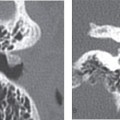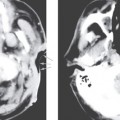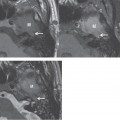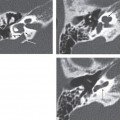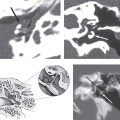CHAPTER 2 External Auditory Canal
Embryology
The external auditory canal (EAC) is a derivative of first branchial cleft that lies between the first (mandibular) and second (hyoid) branchial arches. The first branchial cleft or groove is derived from ectoderm and contributes to form the EAC, the cuticular layer of the tympanic membrane, and the tympanic ring. During embryogenesis, the dorsal portion of the first branchial cleft persists to form the EAC, whereas the ventral portion disappears. However, persistence of the ventral portion may result in the development of a first branchial cleft anomaly, for example a cyst, sinus, or fistula.
Although the ectoderm of the medial first branchial cleft begins to invaginate around the 4th week of embryonic development, the corresponding endodermal evagination from the pharynx grows outward and the two come in contact briefly. The first pharyngeal pouch subsequently becomes the eustachian tube, the tympanic cavity, and its epithelial lining. By the 5th week of embryonic development, mesoderm grows between the ectodermal and endodermal layers, and ultimately the tympanic membrane is formed by all three germinal layers.
Ectoderm of the first branchial cleft gives rise to the EAC, which develops as an invagination at the site of the future auricle at the 4th gestational week. By the 8th week, a solid core of epithelium arises and extends to the area of the middle ear space, separated from it by a thin layer of mesoderm. At approximately 28 weeks, this core begins to recanalize from medial to lateral until the surface ectoderm is reached, giving rise to the external auditory canal. At its medial extent, ectoderm persists as the outermost layer of the tympanic membrane, with the mesodermal layer reduced to a fibrous sheet interposed between outer ectoderm and inner cuboidal endoderm.
Stay updated, free articles. Join our Telegram channel

Full access? Get Clinical Tree


